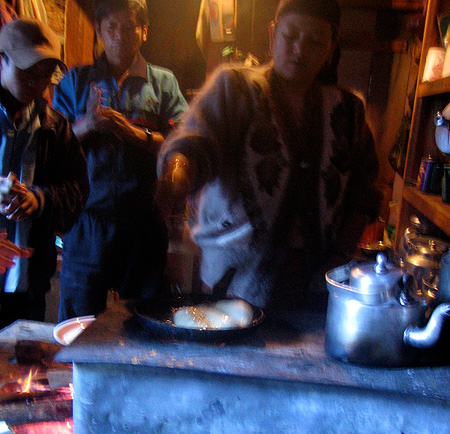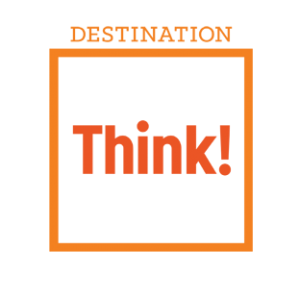The Archives
-
Internet, social media, Travel & Tourism
You’re already in social media; ignore or engage

I still get questions from tourism businesses who aren’t sure if and how they should engage in social media. The answer is that you already are part of social media.
- People write reviews about your business on Tripadvisor
- People tweet about your experience on Twitter
- People check-in with your business on Foursquare
- People talk about your business on Facebook and post pictures
- etc
So the question is “to ignore” or “to engage”. Answer these questions:
- If a customer has a question or feedback at your front desk, do you ignore or engage?
- If somebody calls you with a question or feedback over the phone, do you ignore or engage?
How is social media any different?
-
leadership, Management, Marketing, social media, Travel & Tourism
To be Authentic

The best meal I ever had wasn’t at a fancy restaurant, made by a celebrity chef, with an award winning wine. It was at a small B&B in Chame, Nepal. Because it was freezing cold we huddled around the kitchen fire where dinner was being made.
The whole family helped out. Kids were preparing veggies, the husband was making the dough for bread and mom was in charge of everything and everybody. Friends and family came and went.
That Dal Bhat was the best meal I’ve ever had. Because it was an authentic experience.
The word authentic keeps popping up lately. Tourists increasingly want authentic experiences. In social media, you need to be authentic to be successful. To be authentic is to be real and genuine.
Simon Sinek, who writes fantastic stuff about leadership by the way, talks about imperfection and authenticity in this blog post.
Perfection comes out of molds or off assembly lines. Things made by nature or by hand are imperfect. It is their flaws that make these objects unlike any other of their kind. It is their imperfections that make these things unique and beautiful.That’s why so much marketing is junk. People try to make it too perfect and as a result, the message isn’t authentic anymore. It’s like most marketing comes from the same assembly line. Killed by process, approvals and egos.
Imperfection is not always a bad thing, when it creates authenticity. Keep this in mind for your business. Don’t mold it like everybody else’s (but don’t use your bathroom as a place for imperfection). Give staff some room to be themselves so they don’t sound like robots and give them the ability to think on their feet and give customers personalized attention.
And in social media, authenticity is a must. Don’t always try to craft the perfect message. Be yourself and try to have meaningful relationships with your network. Just don’t be stupid. And when you make a mistake, apologize.
I’ll finish by quoting Simon one more time.
Great leaders don’t try to be perfect, they try to be themselves. And that’s what makes them great. -
Marketing, social media, Travel & Tourism
Something to talk about
06.17.10 | Permalink | 3 Comments
What do travellers talk about after they’ve experienced your tourism business or destination?
In Vancouver, we have many hot-dog vendors. They’re all the same. Some have more condiments than others. That’s pretty much the only difference.
Then this new hot-dog vendor called Japadog popped up. Right in front of our office. Every day, when I leave for lunch, there’s a line-up. The vendor across the street has nobody waiting.
Why? What’s the difference?
Japadog does hot-dogs different. Their menu includes hot-dogs with seaweed, soy, edamame, bonito flakes, fried cabbage and other Japanese goodness.
Everybody’s talking about Japadog. People take pictures and post them on Flickr and Facebook. People talk about it on Twitter. Brag about it on blogs.
What will people talk about when they’ve experienced your business of destination? When an experience is mediocre, there’s nothing to talk about. But with a little creativity, you can give people a reason to talk, tweet and post, giving others a reason to visit.
-
Internet, Marketing
Online & tech trends I’m watching in 2010
01.04.10 | Permalink | 3 CommentsIn travel technology, I’m keeping an eye on these trends. These trends are at the front of massive change in the way we conduct our business.
Social
66% of the global internet population is using social networks. For many around the globe, Facebook is the primary way of staying in touch. It has over 350 million users. Tripadvisor reported over 25 million visitors in November and WAYN has built a network over 15 million members. Building your network of friends or followers, leveraging your brand advocates, encouraging word-of-mouth recommendations and listening and interacting with your customers through social media channels is going to be a must. Instead of marketing to encourage people to visit your channel, bringing your content and services to where the people already are is going to be more effective.And social networks can add value to your own channels as well. OpenID, Facebook Connect, Google Friend Connect, Sign in with Twitter are all tools that allow third parties to use a user profile as part of their website or application. This makes it easier for users to sign-up and provides opportunities for website operators to leverage a user’s profile and social graph while integrating content and services into social networks.
Mobile
In 2010 mobile will explode. Apple will release it’s tablet, Google’s Android is gaining momentum and others like Nokia and RIM are still strong contenders. Competition drives innovation and therefore devices and operating systems will get better and better. Travel is already the third most popular mobile app category but we’re really only scratching the surface.And connected to the first trend, more and more people use their mobile to access social networks, Facebook already reports 15 million active mobile users.Location Based
Somebody at home, in transit, or in a travel destination has different needs and this is where the real opportunity is. Mobile devices know your location, and even what direction you face. This allows for targeted information and services. Augmented reality might be novelty today, but it demonstrates the potential. Enhancing the tourism experience, providing customers service, upselling and cross-selling based on location and time will soon become expectations rather than novelty.Real Time
If you combine the previous 3 trends, you end up with real time information and services. Twitter is the new news ticker. Somebody will break news seconds after it happens on Twitter and the network distributes faster than any traditional news media can. This will enhance the tourism experience as well. How long are lineups for an attraction? Where is a cool band playing? Where are my friends doing or recommending right now?
-
Internet, Marketing, social media
Must see presentations: #2 Clay Shirky: How social media can make history
12.05.09 | Permalink | 2 CommentsClay Shirky’s powerful presentation at TED earlier this year will combat any Social Media sceptic you might have to deal with in your organization. Do you have key business decission makers who don’t even have a Facebook account, or marketing teams who think Social Media is just another way to broadcast advertising or something viral? In that case, this presentation will explain in 17 minutes that the future of marketing isn’t broadcast but collaboration with your networks of consumers and stakeholders.
-
Marketing, Travel & Tourism
Mickey’s 10 Commandments
11.16.09 | Permalink | 2 CommentsI’m working on an idea I’ve had for a long time with the working title “Disneyworld as the perfect DMO”. Here’s a piece of knowledge from Disney every DMO or travel business can copy-and-paste and hang on their walls.
Mickey’s 10 Commandments
- Know your audience – Don’t bore people, talk down to them or lose them by assuming that they know what you know.
- Wear your guest’s shoes – Insist that designers, staff and your board members experience your facility as visitors as often as possible.
- Organize the flow of people and ideas – Use good story telling techniques, tell good stories not lectures, lay out your exhibit with a clear logic.
- Create a weenie – Lead visitors from one area to another by creating visual magnets and giving visitors rewards for making the journey
- Communicate with visual literacy – Make good use of all the non-verbal ways of communication – color, shape, form, texture.
- Avoid overload – Resist the temptation to tell too much, to have too many objects, don’t force people to swallow more than they can digest, try to stimulate and provide guidance to those who want more.
- Tell one story at a time – If you have a lot of information divide it into distinct, logical, organized stories, people can absorb and retain information more clearly if the path to the next concept is clear and logical.
- Avoid contradiction – Clear institutional identity helps give you the competitive edge. Public needs to know who you are and what differentiates you from other institutions they may have seen.
- For every ounce of treatment , provide a ton of fun – How do you woo people from all other temptations? Give people plenty of opportunity to enjoy themselves by emphasizing ways that let people participate in the experience and by making your environment rich and appealing to all senses.
- Keep it up – Never underestimate the importance of cleanliness and routine maintenance, people expect to get a good show every time, people will comment more on broken and dirty stuff.
Martin Sklar, Walt Disney Imagineering, Education vs. Entertainment: Competing for audiences, AAM Annual meeting, 1987
-
Internet, Marketing, Travel & Tourism
Hotel ‘behind the scenes’ blog
09.12.08 | Permalink | 4 CommentsI’ve started to incorporate 5 e-marketing tips for tourism operators in my presentations for a while. They were the inspiration for the “Marketing your small tourism business in the 21th century” were based on.
One of my tips is to start a blog. I always envision this blog were an operator can provide some ‘behind the scenes’ info about their property. Introduce the staff, the experience, guest comments, etc. I’m sure every business deals with hilareous moments as well that would be fun (and appropriate) to share.
The Opus Hotel here in Vancouver has an awesome blog, but I’m always looking for something a little less corporate. And I could never find one, until today. The Hawtorne Hotel is a 3 star hotel in Salem, MA. They’ve posted stories about the hotel, its gardens, the town, their staff, guest comments, special menu items from their restaurant since March 2005. In the 3.5 year, they’ve accumulated almost 2000 postings.
I think it’s a great example of using a blog to create a connection with potential visitors. I would suggest to share more stories instead of making announcements. Where people travel, stories happen.Where people work, stories happen. Somebody with a bit of wit can create a great blog that can create a following like a soap opera. People will want to visit the real deal and be part of the story.
Marketing your small tourism business in the 21th century: -
Marketing, Travel & Tourism
Marketing your small tourism business in the 21th century: #7: Get your content our there
I posted about the importance of a good website. But you have other options to connect your content with potential visitors. Instead of bringing people to your website, bring your content to the people.
There are plenty of places to do this. Most DMO’s offer a listing program where you can describe your business to potential customers on a dedicated page on their website. A DMO website is a good place to start because this is the place where you can find people who are already expressing interest. At Tourism BC, we offer our HelloBC listing program at TourismBC.net.
And there are other places. Yahoo travel allows you to add your hotel or attraction. Free. Google offers you the ability to provide them information about any business for Google Maps. Free.
There are more places, including dozens of online directories. You don’t have to go crazy because some will be more relevant to your business than others. Some are free, some will charge you. You’ll have to decide for yourself and be careful where you spend your money.
A good rule of thumb is to look at the traffic the website generates and the relevancy to your business. High traffic and high relevancy is where you want to be. But check the content on tourism related websites first. The content should be relevant and accurate.
If you’re charged for a listing, it’s important to measure the results. Directly, by measuring the incoming visitors to your website (available through your website analytics). Or indirectly, by asking your customers where they found out about your business.
At Tourism BC, our listings are very detailed and often a consumer won’t visit an operator website because the information is all there. So we can tell operators how many times the listing was viewed on our websites.
The next logical step is to send your inventory out into the world. This is more complicated and could involve changes to the way you run your business. So we’ll leave that post for a later time.
Previous entries in this series: -
Internet, Marketing, Travel & Tourism
Marketing your small tourism business in the 21th century: #6: Be found in Search Engines
04.26.08 | Permalink | 4 CommentsThe first 5 topics have been focused on giving people a remarkable experience, encouraging people to talk about it, and give resulting interested consumers access to your website to close the sale.
And how will people find your website if there’s mention or link to your website? A Search Engine of course. Travel planning starts with a Search Engine. People don’t even bother remembering URL’s anymore (in the Japanese subway, they now advertise Search Terms instead of URL’s). You need to be found in Search Engines. The art and science of making sure you have good placement in Search Engines is called Search Engine Optimization (SEO). Paying for those little ads on the side of the results is called Search Engine Marketing (SEM).
The most important thing is when somebody searches for the name of your business, your website has to show up high. Start by testing this out. Just search for your name and check if you’re in the top results. Make sure you also check for other ways people might search for your name. Also search for your name plus the name of your city or community. Unless you have a common name, your business should be #1, #2 or #3.
If you don’t show up at all, you have a big problem. And if you don’t show in the top 5, you still have a problem. In most cases it means your web professional hasn’t considered Search Engines when building your website. For a list on how to make your website Search Engine Friendly, check our these guidelines from Google’s Webmaster Central (or send the list to your web professional). Start there, and in a later post I’ll share what else you can do to improve your SEO. If you can’t wait, check Search Engine Watch.
The second thing you can do in Search Engines is pay for placement. Create an ad in a Search Engine for specific keywords and you pay each time somebody clicks to your website (Pay Per Click, or PPC). Managing PPC campaigns is a specialist skill, but if you stick to the basics, you can experiment with this yourself. You can manage you Search Engine Ads in Google, Yahoo and MSN through self service and a credit card. There are four core tactics to consider; the keywords you target, your bid, the copy of your ad, and your landing page.
My recommendation is to start very specific and slowly broaden things out. Start with very specific keywords. If you are ACME Golf course in Someville. Target the keywords “ACME Golf” and “Golf Someville” for example. Don’t target “Golf”. If might drive a lot of traffic, but it will also drive up cost and it’s unlikely they will convert into a visitor. Choose the geographic area where your ads will show carefully. Where does your typical visitor come from? Start there. Be carefull how much you bid, and set limits so you don’t blow through your budget. And most of all, monitor the results. What’s working, what’s not working, and adjust frequently.
You probably realize that it can get complicated and time consuming quickly. So think twice before you engage in this and consider hiring a professional to manage your SEM. It’s worth it.
Previous entries in this series: -
Uncategorized
Marketing your small tourism business in the 21th century: #5 Find your target audience and join the conversation
04.05.08 | Permalink | 2 CommentsIn my last post in this series I wrote about encouraging your customer to share their experiences online. Now lets take that concept one step further. You can participate in the online discussion. Some call it “joining the conversation”. By joining, you can make new people aware of your business, but also learn a great deal about your target audience. You might even get a new idea about how to make your business more remarkable.
This is really part of #3 Monitor and Respect Tripadvisor. But I consider Tripadvisor a must-do, while this is a nice-to-do. I understand that the operational side of running a business takes up time enough already so you’ll have to monitor if your efforts are paying off. Maybe there’s a creative way. Use a family or a staff member. Starwood Hotels has somebody employed to answer questions on Flyertalk, a frequent traveler community.
An important aspect of engaging in online communities is that you can’t use traditional marketing tactics. In most cases it’s completely inappropriate to advertise your business. And in Europe, there’s talk about making it illegal. Here’s an bad example from the Lonely Planet Thorn Tree forum:URGENT!! LOOKING FOR 2 PAX TO JOIN A SAFARI
Hi every one
We are looking for two more people to join a 4 days Camping Safari to Ngorongoro and Serengeti starting from 24th May 2007 to 27th May 2007.
Please Contact us USAP ON xxxxxThis sound like a group who are looking for some people to travel with. No, it’s not.
“Us” meaning ‘our company.’
Stop advertising here Shidolya. You’ll get a bad name.It’s very easy to destroy your reputation and credibility. Don’t be tempted but play by the rules. The risks of getting caught and getting a bad name are too big.
It’s a very delicate line. The best thing to do is to be genuinely helpful. The opportunity you have is to be seen as an expert. An experts of the area where you live, and the secor you represent. If you run a eco touring company in Parksville for example, become the eco expert of the Parksville area in a relevant online community. If you’re helpful, people might seek your services over others as a reward. If you do say something that’s related to your business, stay in context of the conversation and offer full disclosure. The best thing to do is add your website URL in a signature and let people decide for themselves. Here’s a good example:You can visit Tambunan Rafflesia Reserve whn you are at KK, by taking a minivan to Tambunan that only cost your around RM 10. Journey will take approximately 30 to 40 mins only. Note that visit to Tambunan Rafflesia Reserve doesn;t guarantee you that you will spot the blooming rafflesia…
Your ultimate Borneo Longhouse Adventure & Homestay Program:
www.LonghouseAdventure.comSo find the right community for you and join in. It’s fun, you’ll learn a lot, and hopefully drive some customers your way.

